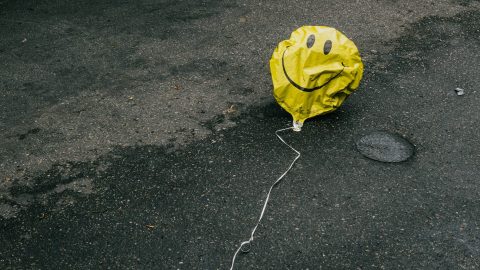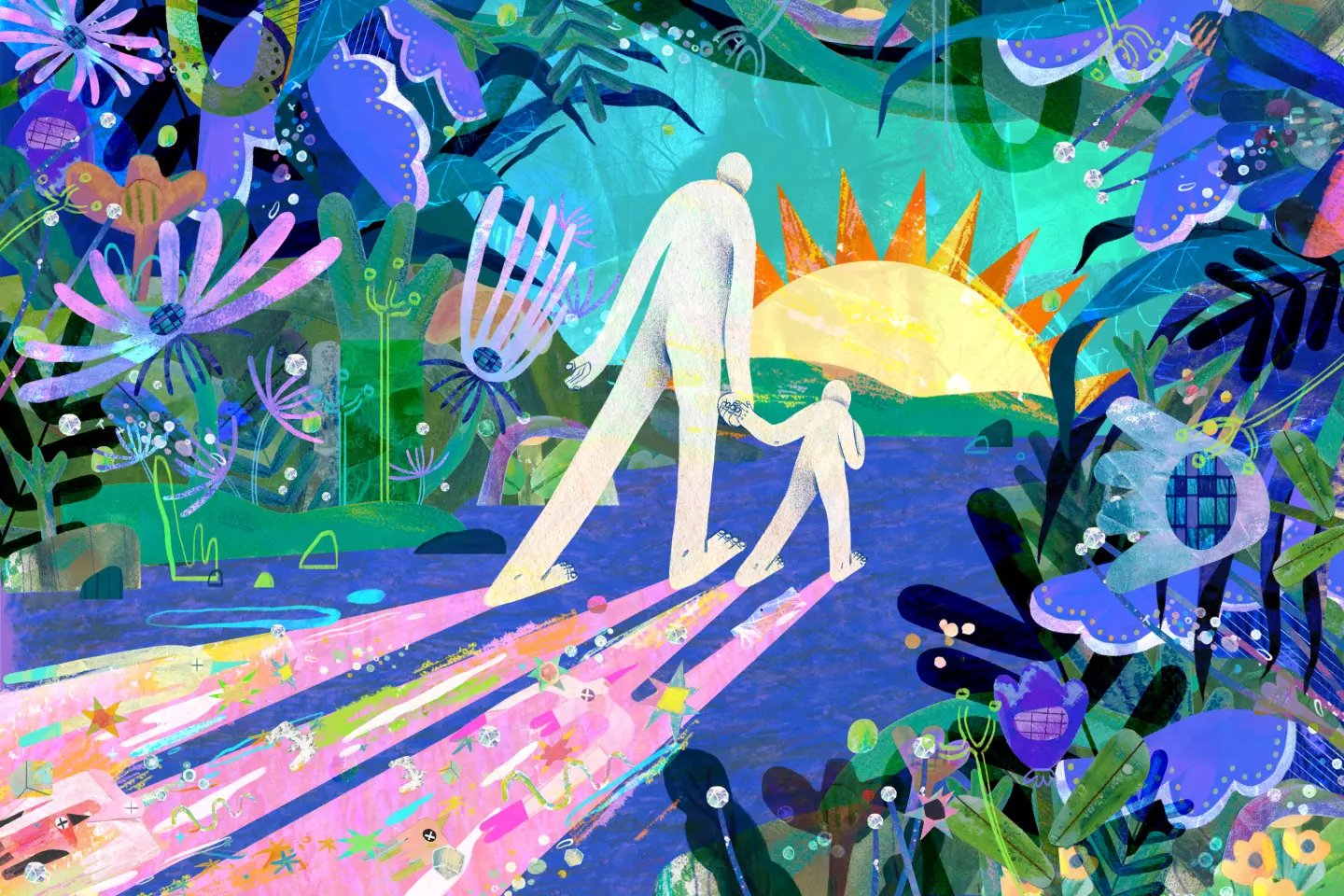


We all want to be happy — and for decades, psychologists have tried to figure out how we might achieve that blissful state. The field’s many surveys and experiments have pointed to a variety of approaches, from giving stuff away to quitting Facebook to forcing one’s face into a toothy grin.
But psychology has undergone serious upheaval over the last decade, as researchers realized that many studies were unreliable and unrepeatable. That has led to a closer scrutiny of psychological research methods, with the study of happiness no exception. So — what really makes us happy? Under today’s more careful microscope, some routes to happiness seem to hold up, while others appear not to, or have yet to re-prove themselves. Here’s what we know so far, and what remains to be reassessed, according to a new analysis in the Annual Review of Psychology.
One long-standing hypothesis is that smiling makes you feel happier. In a classic 1988 study, researchers asked 92 Illinois undergraduates to hold a felt tip pen in their mouth either with their teeth, forcing an unnatural grin, or with their lips, making them pout. The students then looked at four examples of The Far Side comics. On average, those with the forced smiles found the one-panel comics slightly funnier than those with the forced pouts.
One solution has been for scientists to publicly declare, or preregister, their analysis plans before they conduct their experiments. In other words, they draw the bullseye first. Dunn and her graduate student, Dunigan Folk, homed in on such preregistered studies in their analysis, which narrowed the vast field of happiness research to just 48 published papers. Even that small number is encouraging, says Brian Nosek, a psychologist at the University of Virginia in Charlottesville and executive director of the Center for Open Science, which aims to improve research reproducibility. “I was actually surprised that there were as many papers that qualified,” he says. “That really demonstrates that this area of research has adopted a lot of these new rigor-enhancing practices.”
Read the rest of this article at: Big Think
Paola Magni didn’t plan on getting involved in her most infamous case. As a forensic entomologist, she researches how insects and related creatures found at crime scenes can help investigators solve mysteries. She frequently works with public health officials and coroners, who, perhaps surprisingly, are often repelled by vermin, critters and crawlers. “Pathologists hate bugs,” she says of the doctors who examine corpses. But her comfort with these widely loathed creatures, combined with a talent for communicating forensic concepts to the public in press interviews and on social media, have propelled her to the forefront of innovations in forensic biology. She has consulted on dozens of homicide cases and suspicious deaths all over the world. In association with the local health service, she established Italy’s first forensic entomology laboratory, then housed in the Turin morgue. A smartphone app she created called SmartInsects, which helps investigators identify bugs and guides them in how to collect samples, has been downloaded more than 40,000 times, mainly by pathologists, law enforcement officers and students. And by applying her expertise to all the living organisms that arrive opportunistically at crime scenes like uninvited party guests, from flies to barnacles, Magni has become a leading figure in the burgeoning field of aquatic forensics, which extends the science of criminal investigations to evidence found in bodies of water.
But in 2012, before she became an international figure, she was still completing her doctorate in biology in her native Turin, in northern Italy. One November morning that year, a passerby spotted a teenage girl lying face down near Lake Bracciano, 400 miles south of Turin. The lake, a tranquil spot where unusually friendly swans compete with ducks and geese for bread tossed by people on the shore, attracts residents from nearby towns and day-trippers from Rome, about a 45-minute drive south.
The body was identified as belonging to 16-year-old Federica Mangiapelo, from the nearby town of Anguillara Sabazia. There were no major signs of trauma or foul play, but the young woman’s shoulder was dislocated, her jacket was half-removed, and her handbag and cellphone were missing. Her blond hair, clothes and shoes were wet, but that didn’t necessarily indicate she’d been in the lake; the preceding night had been rainy, after all. An autopsy showed that she had suffered cardiac arrest and died four hours before the cyclist found her. In the absence of hard evidence suggesting otherwise, authorities concluded she had died of “natural causes,” perhaps related to the epilepsy she’d reportedly suffered as a child. But Federica’s family was adamant that their daughter, who as far as they knew was perfectly healthy, could not have suddenly died in such mysterious circumstances, and they worked to keep the case alive in the media.
Read the rest of this article at: Scientific American
For the 10 years they were together, Kristen de Marco and her terrier Gracie were inseparable. De Marco brought her dog to work each day, and routinely left dinners and parties early to rush home to her; she skipped her 20th high-school reunion because Gracie was sick and none of the available hotels could accommodate a dog. De Marco’s dedication sometimes struck friends, family, and colleagues as odd. When they heard that de Marco would pay to bring Gracie on every single plane ride she took, “people were like, It’s just a dog, put her in the boarding facility,” de Marco told me. “But she was so attached to me, and I to her.” To her, Gracie was family—“my first child.”
De Marco’s feelings about Gracie put her on one side of a split in the American mind. In many ways, people have never been more openly obsessed with their pets. Companion animals now get their own home-cooked foods, their own strollers, their own memory-foam mattresses (if they don’t prefer ours); they have their own clothing lines, wellness centers, and trusts. They are trained to use toilets and driven to day cares; they feature in weddings and are written into wills. When they fall sick, they’re offered acupuncture, surgeries, chemotherapy, even organ transplants. In 2022, Americans shelled out some $136.8 billion for pet care. A recent Pew survey found that almost every pet-owning American—all 200 million of them—describes their animals as family, and more than half of pet owners say their pet is “as much a part of their family as a human member.”
Read the rest of this article at: The Atlantic
The older I get, the more I enjoy acting like a kid.
I jump at every opportunity to do backflips in the pool and absolutely love seeing the circus when it’s in town. I’ll giggle over banana splits at Fluffy McCloud’s and relish the silly moments when my friends want to watch an animated movie or order an absurd treat like Carvel’s “Fudgie the Whale” ice cream cake. Every few months, my partner and I make a pilgrimage to the desert where we climb huge rocks and lie beneath the stars to feel existentially tiny.
I’ve loved all of these activities since I was young, but my last year has been especially joyful since I started learning the art of childlike wonder.
The phrase first came into my life as a way my partner would justify ordering Shirley Temples, but the more I thought about childlike wonder, the more I began to notice it. I’d find posts about it on social media and contemplate it with friends, including my co-worker Kailyn, who told me about the whimsy she felt as she rolled down a grassy hill at the Getty Center.
And though these notions aren’t new to the world, recent research shows that experiencing awe and wonder can positively affect our mental and physical health, ultimately benefiting our lives. So in 2023, I sought out experts on awe and play and tried to reframe my life in L.A. around the big and tiny things that propel people into states of reverence and joy.
Through this, I discovered something profound yet simple: with the right perspective, and a little bit of effort, we can teach ourselves to generate childlike wonder in all sorts of places.
Read the rest of this article at: Los Angeles Times
Before they disappeared into the mountains — before they broke the foremost rule of womanhood: Keep the children alive — Becky and Christine Vance lived together in Colorado Springs in the Windmill Apartments, a modest complex with a heated outdoor pool that looks like a large Days Inn. From the parking lot, you can see Pikes Peak rising from the plains like a mirage or a matador’s cape. The Vance sisters, as adults, did not go camping, nor had they ever climbed Pikes, though they had taken Becky’s son to the North Pole, an amusement park on its northeastern slope where you could ride the Candy Cane roller coaster and visit Santa’s Workshop.
The Vance sisters had lived together their entire lives except during two stints, each lasting less than a year, when one of them tried to move out. Becky was born in 1980, Christine in 1982, but Christine’s friends (Becky didn’t have friends) considered their relationship to be like that of twins. “You know with twins how there’s one that’s kind of more in charge?” one of those friends said. “Becky kind of seemed, like, more alpha.” Both sisters inherited their mother’s thick black hair, almond skin, and dark eyes, though Becky was leaner and taller, and she felt a peculiar, almost gladiatorial duty to protect her sister. This started, as far as anybody could tell, when Becky was 5 and Christine was 3 and their mother abruptly left their father, taking her children with her.
Seven years later, their mother remarried and the girls acquired a stepsister. Trevala, who was rowdy, blonde, and emotionally porous, was two years younger than Christine. In high school, those two hung out a lot, Christine accompanying Trevala as she stirred up conventional trouble — smoking weed behind the arcade, hooking up with boys in the utility elevator. Becky didn’t join. Becky worked at Papa Johns after school, then came home. Becky earned perfect grades, stood with perfect posture, kept her chin tilted up, and rarely spoke. At first, Trevala found her reserve intimidating. “Just the mysterious privateness of her,” Trevala told me. Becky “gave off this aura: ‘I’m not going to talk to you until I trust you. You better not be on my bad side.’ If you were on Becky’s bad side, you were on it for a while.”
The three girls shared the basement of the Vance family home, a ranch house on a leafy, modest Colorado Springs street. After graduating from Mitchell High School, Becky and Christine kept living there, working at Sears (Becky) and Taco Bell (Christine). In their early 20s, both sisters took jobs at Atmel Corporation, a semiconductor-manufacturing plant, in one of those clean environments where you have to wear a white smock, white shoe covers, a mask, and a hair net.
Read the rest of this article at: New York Magazine



:focal(2250x1693:2251x1694)/https://tf-cmsv2-smithsonianmag-media.s3.amazonaws.com/filer_public/63/15/6315c267-0a48-4ca5-a557-dfb02334f1b3/opener_-_janfeb2024_c06_paolamagniforensics.jpg)


